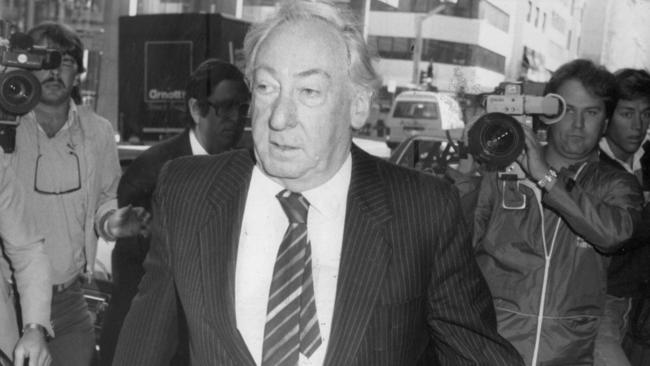Scandalous Lionel Murphy mysteries set to be laid bare
All the political intrigue and underworld connections behind the Lionel Murphy saga are set to revealed more than 30 years on.

All the scandal, political intrigue and remarkable web of underworld connections that lie behind the troubled story of Lionel Murphy are set to be laid bare on Thursday when thousands of documents kept secret for more than 30 years are released for the first time.
Nothing like the Murphy case has been seen in Australian history: here was a judge of the High Court, the most supreme in the land, and formerly attorney-general in the Whitlam Labor government, subjected to two criminal trials on charges of attempting to pervert the course of justice. Found guilty on one of two charges, and facing prison, Murphy successfully appealed.
He was retried on one charge and found not guilty. He then faced a parliamentary commission of inquiry to test his fitness to remain on the bench under section 72 of the Constitution, related to misbehaviour by a judge, when still more allegations about his conduct surfaced.
The most serious was that he had tried to bribe a police officer.
The details of that 1986 inquiry by three retired judges, called off when it was revealed Murphy was dying from terminal cancer, have now been approved for release by the House of Representatives Speaker Tony Smith and Senate president Stephen Parry.
They were initially to be released in July but that was delayed so family members of those named could be alerted and some signatures and address details could be redacted.
Legal experts such as Stephen Walmsley SC, a retired District Court judge who wrote a book, The Trials of Justice Murphy, on the saga, expect some shocks from these “Class A” secret documents. Even if most of the topics have been well aired in the public domain, Walmsley says surprises are in store when the detail of what really happened comes to light from a trove of information.
“How more shocking can it get when a High Court judge is charged?” Walmsley said. “One of the three arms of government goes on trial twice for very serious offences — and for the first was sentenced to a term of imprisonment. I think the release of these documents will educate people.” To this day, Murphy remains a polarising figure. While the most trenchant critics insist he was a reckless and deeply corrupt figure whose unchecked behaviour was an insult to the law he professed to uphold, his surviving supporters maintain the man was badly misunderstood, as a fighter for social justice, a bon vivant and ultimately a flawed martyr pursued relentlessly by his enemies.
Even at the end of his life, Murphy managed to stir the pot at the highest levels.
Determined to sit again on the bench, despite rumours his colleagues did not want him to, Murphy presided one last time in October 1986 to deliver a final decision. He died an hour later, aged 64.
The source of Murphy’s woes, apart from his own alleged failings, was his connection to Sydney solicitor Morgan Ryan. Unlike other judges who would distance themselves from anything nefarious or suspect, Murphy seemed to have no qualms about socialising with Ryan, who not only represented Sydney crime boss Abe Saffron but was his partner in business.
It did not stop there: Murphy was mates with chief stipendiary magistrate Murray Farquhar, later found to be corrupt, and crooked NSW police commissioner Merv Wood. He was apparently happy to discuss cases with them. Critics claim he was part of their bent network.
Murphy was committed in June 1985 to stand trial on two charges of attempting to pervert the course of justice in relation to allegations he improperly sought to influence NSW District Court judge Paul Flannery and NSW chief magistrate Clarrie Briese.
Ryan’s phone had been tapped by police four years earlier and he was facing conspiracy charges over an illegal immigration racket to unlawfully gain permanent residency status for a group of Koreans. While Murphy was acquitted of the charge related to Flannery, he was found guilty on the Briese matter. After his successful appeal, he faced a second trial on the Briese matter alone, and was acquitted.
Amid all the drama of the Murphy trials, there were standout moments. The most damaging claim, which Murphy denied, was that he had sought to improperly influence Briese in the Morgan case during a dinner party with the quoted line: “And now, what about my little mate?”
Lawyers remember that Ian Callinan QC, Murphy’s prosecutor and later a High Court judge, insisted during the trial on calling Murphy the accused. Unlike some barristers, he did not give him the title of His Honour.
Looking back at that era, Walmsley, who had a connection to the case through his father-in-law, Flannery, was asked by Justinian publisher Richard Ackland what he had learned that was new from the Murphy trials.
He recalled: “Much, but of great interest to me was that Malcolm Turnbull had once been such a leftie, going in hard for Murphy when writing for The Bulletin, receiving great praise for his work from Bill Hayden and the late Jim Cairns.”
With the trials over, another Murphy defender, former Hawke government attorney-general Gareth Evans, declared the allegations “against Justice Murphy have been dealt with comprehensively, fairly and finally by the criminal courts”.
It was not to be. At least seven matters, according to Walmsley, came to light in fresh allegations. They included not only the claim Murphy had tried to bribe federal police officer Don Thomas, but he may have had business dealings with Saffron of his own.
The three retired judges whose work is set to be released this week were given a brief to look at new allegations against Murphy, and not to rake over matters that were canvassed in the trials.
There is much curiosity, however, about exactly what raw material they needed to sift through and investigate to reach their conclusions, which should be among the documents released.
Murphy’s name is understood to have come up in federal police phone taps, known later as the Age Tapes. He is believed to have rated consideration by the late judge Don Stewart in confidential sections of his royal commission report into organised crime in the 1980s.
The saga of Lionel Murphy has never really ended, but it might on Thursday.



